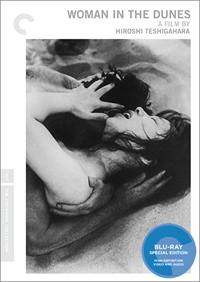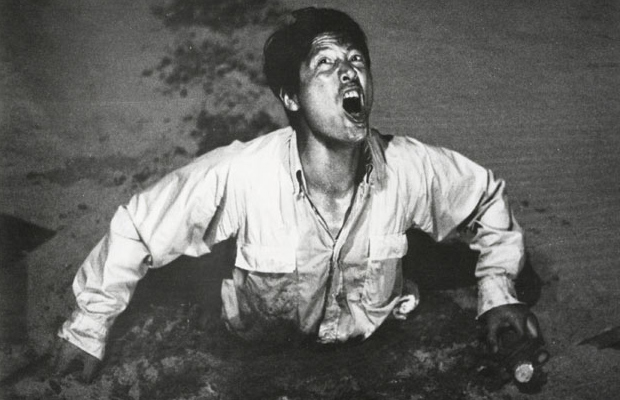Disc Reviews
Criterion Collection: Woman in the Dunes | Blu-ray Review
 Arguably one of the most enigmatic figures associated with the loosely defined Japanese New Wave of the 1950s and 1960s is Hiroshi Teshigahara, who independently financed a quartet of striking features which were collaborations with avant-garde novelist Kobo Abe. Previously, Criterion had restored three of these in 2007 for a superb box set of the director’s work, including his feature debut Pitfall (1962) and The Face of Another (1966). These two titles are curiously absent from the new Blu-ray transfer/high-def digital restoration of the label’s re-release of the other title, 1964’s Woman in the Dunes, but this is undoubtedly the jewel of their collection, as well as Teshigahara’s unrivaled directorial achievement in mood, tone, and visual intoxication. After premiering in competition at the Cannes Film Festival, it won the Jury Prize (losing out to The Umbrellas of Cherbourg), and went on to be nominated for two Academy Awards, the first in 1964 for Best Foreign Language film, and then a year later Teshigahara would score a nod for Best Director (losing to Robert Wise for The Sound of Music).
Arguably one of the most enigmatic figures associated with the loosely defined Japanese New Wave of the 1950s and 1960s is Hiroshi Teshigahara, who independently financed a quartet of striking features which were collaborations with avant-garde novelist Kobo Abe. Previously, Criterion had restored three of these in 2007 for a superb box set of the director’s work, including his feature debut Pitfall (1962) and The Face of Another (1966). These two titles are curiously absent from the new Blu-ray transfer/high-def digital restoration of the label’s re-release of the other title, 1964’s Woman in the Dunes, but this is undoubtedly the jewel of their collection, as well as Teshigahara’s unrivaled directorial achievement in mood, tone, and visual intoxication. After premiering in competition at the Cannes Film Festival, it won the Jury Prize (losing out to The Umbrellas of Cherbourg), and went on to be nominated for two Academy Awards, the first in 1964 for Best Foreign Language film, and then a year later Teshigahara would score a nod for Best Director (losing to Robert Wise for The Sound of Music).
Simply put, it’s the story of an entomologist (Eiji Okada) who flees his taken-for-granted urban splendor to seek fame and glory in desolate, uncharted desert dunes for a new, undiscovered species of tiger beetle. Instead, he stumbles upon a meager group of villagers who convince him to stay overnight when he misses the last bus out of the dunes, the only available bed at the bottom of a pit in a house inhabited by a forlorn widow (Kyoko Kishida). Upon waking in the morning, the man finds himself unable to leave, and forced into laboring alongside the woman in her daily Sisyphean ritual of digging out the falling sand which threatens to swallow them. In turn, the villagers sell the sand to buyers for the construction of buildings. Without a man in her home (a recent sandstorm consumed both her husband and her child, grotesquely buried somewhere in the near vicinity), the villagers refuse to allot her food rations, and so the professor has been used as a sacrifice to become her savior.
Woman in the Dunes is a rare achievement, both as parable making considerable use of social commentary, (on community vs. the individual, man vs. woman), and as a grotesquely titillating arthouse thriller with terrifying suggestions regarding conditioning and the acceptance of fate. The title is often compared to Shohei Imamura’s The Insect Woman (1963) and his documentary A Man Vanishes (1967), both dealing with either gender or identity in similar ways as Teshigahara, particularly in the latter title, which deals with the investigation of a man who has suddenly disappeared from his urban environment.
Discussions of Teshigahara and his peculiar career as a filmmaker make note of his absence from filmmaking in the 1970s. In between 1972’s Summer Soldiers and 1989’s Rikyu, he was almost entirely absent, with the exception being his 1984 documentary named after its subject, architect Antonio Gaudi. Destined to take over his father’s famed flower arrangement school in Tokyo, Teshigahara fulfilled his familial expectations, and echoes of such traditional subservience to social expectations are evident in Woman in the Dunes. But what’s more interesting to note is how his interests in form and texture are crafted slyly throughout Woman, the sand and insects providing various shapeshifting montages throughout the oddly structured visual devices in the film. As has been duly noted, the woman’s home in the sand pit is a physical impossibility, as walls consisting of continually crumbling sand are impossible (Teshigahara himself confirmed they could never get more than a 30 degree angle), although this isn’t evident when watching its two main characters struggling inside of it.
The banter between the man and woman is at first amusing, and Teshigahara seems to use every opportunity to paint the schoolteacher as a cruel, bourgeois bore, a man who carelessly and cruelly treats the insects he plans to becomes famous from with disdain (he also is shown talking to what seems a memory of his wife, a relationship which only made him realize men and women live in constant fear of being cheated). He patronizingly demeans the woman’s statements about sand, how she believes the tiny grains draw water and cause everything around her, including her house and the roof to rot (how this is a concept eventually trapping the man indefinitely is also one of the film’s sly ironies). The man laughs (but not for long), soon waking to a nightmare from which he’ll never be released. Aggravatingly, we don’t learn what the woman has done to earn such a distinction (or punishment) of being placed in the sand pit, but the presence of a man in her environment seems to elevate her standing—no longer is she called the old hag once he assumes his role. Likewise, the man goes from being called ‘teacher’ to ‘helper,’ while any pleas for favors result in quid pro quo from the villagers, who demand cruel debasement. When the village council agrees to grant the man’s request to get out of the hole to see the sea, in turn he must copulate with the woman in front of them as they jeer in crazed Kabuki masks.
Disc Review:
Criterion grants Teshigahara’s title a new high-definition digital restoration (one hopes one day they will get around to treating their other titles from the auteur to the same distinction). Picture and sound quality are superb—of Criterion’s back catalogue deserving of a newly minted Blu-ray transfer, this is one of their most impressive. DP Hiroshi Segawa, who lensed Teshigahara’s first three features and after that only one more feature, Kinji Fukusaku’s 1972 title Under the Flag of the Rising Sun, assists in successfully achieving this highly stylized universe, including an eventual sex sequence where writhing bodies become transposed on natural patterns of the sand (with credit also to editor Fusako Shuzui, who worked on Teshigahara’s Pitfall and Summer Soldiers). Continually mocking its trapped protagonists is an eerie score from Toru Takemitsu, which plays over scenes anxiously, and eventually nauseously, a cacophony of pealing strings. Criterion includes four short films from earlier in his career, as well as several other well-chosen extra features:
Video Essay:
Criterion includes this Video Essay recorded in 2007 from James Quandt of the Cinematheque Ontario (which has since been renamed TIFF Cinematheque).
Four Shorts:
Four shorts directed by Teshigahara (three of them made well before Women in the Dunes) are included here, such as Hokusai (1953), Ikebana (1956), Tokyo 1958 (1958), and Ako (1965).
Teshigahara and Abe:
This thirty-five minute documentary details the working relationship between Teshigahara and writer Kobo Abe, and features a number of interviews recorded in 2006 by Criterion, including film program and professor Richard Pena, Japanese scholars Donald Richie and Tadao Sato, set designer Arata Isozaki, screenwriter John Nathan, and producer Noriko Nomura.
Final Thoughts:
“Are you shoveling sand to live or living to shovel sand?” the man incredulously asks the woman, not long after he’s given into his fate. It’s a question which can’t be easily answered, but Woman in the Dunes is an unforgettable high point from a painstaking auteur, and one worthy of endless deliberation.
Film Review: ★★★★★/☆☆☆☆☆
Disc Review: ★★★★½/☆☆☆☆☆

































